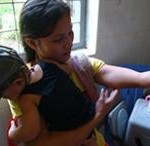Stimulating Demand for VMMC in East and Southern Africa

A poster advertising VMMC services as part of the Brothers for Life campaign in South Africa
The Bill and Melinda Gates Foundation sponsored an Eastern and Southern Africa Regional Meeting April 3-5, 2013, on Demand Creation for Voluntary Medical Male Circumcision (VMMC) in Lusaka, Zambia. Ministry of Health officials, donors, and program implementers from the 14 focus countries in east and southern Africa came together to share lessons learned and discuss innovative ideas for building the evidence that behavior change communication activities have an impact on demand for VMMC.
The meeting stressed the need to better understand the cognitive and structural barriers keeping men from VMMC services, given how complex and contextual VMMC is. Kim Ahanda from USAID/Washington emphasized the importance of understanding the specific behavioral determinants that either motivate or serve as barriers to VMMC. It is equally important for us all to remember that if we only look at numbers of men obtaining VMMC services, we’re not really measuring our progress sufficiently and capturing the intermediary steps that lead men to seek VMMC services to fully capture the impact we’re having.
Expanding upon community engagement approaches and working with traditional leaders are also important in changing social norms in geographic areas that do not traditionally circumcise. Chief Mumena of the Kaonde people in Zambia’s Northwestern province spoke eloquently on a panel focused on the role of traditional and religious leaders in creating demand. He shared his story about his own awakening when he decided to get circumcised and spread the word to his people. He believes he is a “bridge between the past and the present” and that VMMC is a cultural issue. He re-evaluated his culture against his people’s collective need for survival and sought the service. He is now a champion for VMMC and speaks publicly about this prevention strategy.
Another panel focused on innovative demand creation strategies with an emphasis on marketing approaches and more provocative ways to reach men that go beyond positioning VMMC simply as an HIV prevention strategy and instead attach an identity to it. While people may know they are at risk of contracting HIV, many don’t internalize it or judge their long-term risk very well. Creative ideas are therefore needed to engage men and encourage VMMC uptake.
Some of the approaches shared on the panel try to reach men in their target audience with aspirational identities that we want VMMC to have in an effort to attract men’s’ interest. Attaching another identity like the Stylish Man campaign from Rakai, Uganda, is doing or the Love Cut campaign in South Africa are novel ways to reach men. Since emotion is the currency of the mind, simply expecting people to act in rational ways is often misguided. Instead, positioning VMMC with an identity men are interested in is proving successful.
The meeting ended with a call for more research and impact evaluations, which test innovative demand generation ideas for VMMC and set the stage for scale up. While some of the focus countries have had more success than others, the meeting provided an opportunity for multiple stakeholders to learn from others and return home with new ideas for stimulating demand for VMMC.






Leave a Reply
Want to join the discussion?Feel free to contribute!